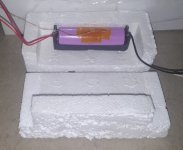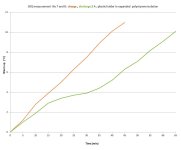If we knew the specific heat capacity and DC IR of the above 18650 cell we could work out the total cell heating and compare it to that predicted by simple ohmic heating - approximately - on account of heat loss due to imperfect insulation, heating of box interior etc.
You are using an out of date browser. It may not display this or other websites correctly.
You should upgrade or use an alternative browser.
You should upgrade or use an alternative browser.
Testing the internal resistance of a li ion cell and making determinations
- Thread starter newb123
- Start date
PaulD
1 kW
Punx0r said:If we knew the specific heat capacity and DC IR of the above 18650 cell we could work out the total cell heating and compare it to that predicted by simple ohmic heating - approximately - on account of heat loss due to imperfect insulation, heating of box interior etc.
It's been a while but I recall using about 0.9 J/gK. The literature seems to agree: http://www.inforlab-chimie.fr/doc/document_fichier_279.pdf
docware said:Balmorhea, when the cells are at the phase of the exothermic reaction, the next phase is usually fire and destruction of the battery (and EV vehicle).

I'm not talking about thermal runaway.
I'm talking about the reversible chemical reaction in the cell. Discharging Li-ion cells is exothermic and charging is endothermic. The amount of heat involved isn't huge, but it's part of the equation.
Hillhater
100 TW
So, an effect similar to the Peuket losses in Pb cells ?Balmorhea said:I'm talking about the reversible chemical reaction in the cell. Discharging Li-ion cells is exothermic and charging is endothermic. The amount of heat involved isn't huge, but it's part of the equation.
.....an effect that has been tested and acknowledged as being insignificant in Li cells.
Balmorhea said:I'm talking about the reversible chemical reaction in the cell. Discharging Li-ion cells is exothermic and charging is endothermic. The amount of heat involved isn't huge, but it's part of the equation.
That´s theory, here are results from real measurement comparing charging and discharging of Samsung 30Q , ambient temp 25°C :


http://ma.ecsdl.org/content/MA2016-02/3/341.abstract
The heat signal which is measured is the sum of the reversible (entropic) heat and the irreversible heat (ohmic and polarization). The irreversible heat is always exothermic while the reversible heat is endothermic on the charge and exothermic on the discharge. Therefore the total heat measured from the discharge (exothermic) will always be larger than the total heat measured from the charge (endothermic).
Balmorhea said:http://ma.ecsdl.org/content/MA2016-02/3/341.abstract
The heat signal which is measured is the sum of the reversible (entropic) heat and the irreversible heat (ohmic and polarization). The irreversible heat is always exothermic while the reversible heat is endothermic on the charge and exothermic on the discharge. Therefore the total heat measured from the discharge (exothermic) will always be larger than the total heat measured from the charge (endothermic).
You probably haven´t noticed that this measurement display total heat from the charge larger than from discharge ?
docware said:You probably haven´t noticed that this measurement display total heat from the charge larger than from discharge ?
I saw that the delta T rate was different. Since even an EPS foam box isn't a perfect insulator, the difference in time to heat makes the difference in final temperature inconclusive. To be frank, I trust the scientists on this matter.
PaulD said:It's been a while but I recall using about 0.9 J/gK. The literature seems to agree: http://www.inforlab-chimie.fr/doc/document_fichier_279.pdf
docware said:DCIR : LG M36 cca 31 - 32 miliohm, LG HG2 cca 21 - 22 miliohm, Samsung 30Q cca 18 - 19 miliohm
Thanks PaulD and docware.
Let's have a go at the M36 cell @5A discharge:
Heating on docware's test: 37°C dT in 30mins (1800s)
Energy required = 0.9 x 48g x 37K = 1598J = 1598W/s = 0.89W average over the 30min discharge [Assuming no heat dissipated from the cell]
Heating expected from DC IR: 5^2A x 0.032ohms = 0.8W
It's a crude comparison but that's a lot closer than I was expecting...
krlenjuska
10 W
- Joined
- Feb 18, 2019
- Messages
- 94
So in reality voltage drop test can give us only DC resistance results - if this is accurate. Also should we measure this at 4.2 voltage or at 3.7V?
Some semi-pro tool like vapcell yr1030 will measure AC resistance which is totaly different thing.
Which one is important for us?
Probably first one - because this way we can compare cells and put together similar cells.
Im newbie in this subject but i try to think logically.
Some semi-pro tool like vapcell yr1030 will measure AC resistance which is totaly different thing.
Which one is important for us?
Probably first one - because this way we can compare cells and put together similar cells.
Im newbie in this subject but i try to think logically.
Hillhater
100 TW
DCIR is more representative of real use, and easier to do without special tools
There is little value in testing at 4.2v since you only get to use that voltage level very briefly before any useful output from a cell.
Likewise any testing at below 3.0v is pointless.
Nominal voltage 3.7-3.8v is best if you are trying to compare cells.
And use a discharge load that is representative of the planned use.
There is little value in testing at 4.2v since you only get to use that voltage level very briefly before any useful output from a cell.
Likewise any testing at below 3.0v is pointless.
Nominal voltage 3.7-3.8v is best if you are trying to compare cells.
And use a discharge load that is representative of the planned use.
goatman
10 MW
Punx0r said:PaulD said:It's been a while but I recall using about 0.9 J/gK. The literature seems to agree: http://www.inforlab-chimie.fr/doc/document_fichier_279.pdf
docware said:DCIR : LG M36 cca 31 - 32 miliohm, LG HG2 cca 21 - 22 miliohm, Samsung 30Q cca 18 - 19 miliohm
Thanks PaulD and docware.
Let's have a go at the M36 cell @5A discharge:
Heating on docware's test: 37°C dT in 30mins (1800s)
Energy required = 0.9 x 48g x 37K = 1598J = 1598W/s = 0.89W average over the 30min discharge [Assuming no heat dissipated from the cell]
Heating expected from DC IR: 5^2A x 0.032ohms = 0.8W
It's a crude comparison but that's a lot closer than I was expecting...
is there a formula to figure how much heat will be created by charging?
I was reading on the endothermic and exothermic cycle of li ion and it looks like most of the heat is generated on the discharge from 3.2v to 2.5v. page 2 of this report but page 3 of the pdf has a chart
https://directory.qmed.com/sites/default/files/Electrochem%20Li-ion%20Battery%20Temp%20Trends.pdf
I want to lifecyclecycle test a 30q at 7amps charge and 7 amps discharge but cant find a tester that will go that high, they seem to be 5amp max charge. I just want to make sure a 30q wont overheat at 7 amps charge, if it does ill just buy the 5amp tester but if it doesn't ill keep looking for a tester.
Similar threads
- Replies
- 10
- Views
- 1,076
- Replies
- 34
- Views
- 1,587
- Replies
- 22
- Views
- 2,260

